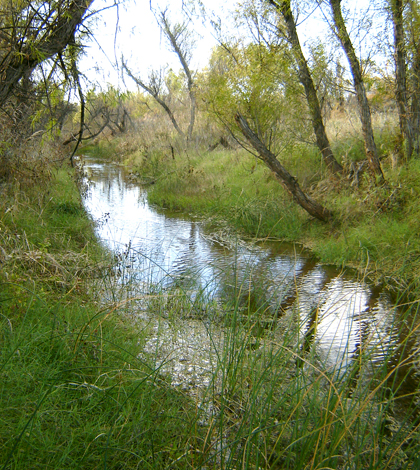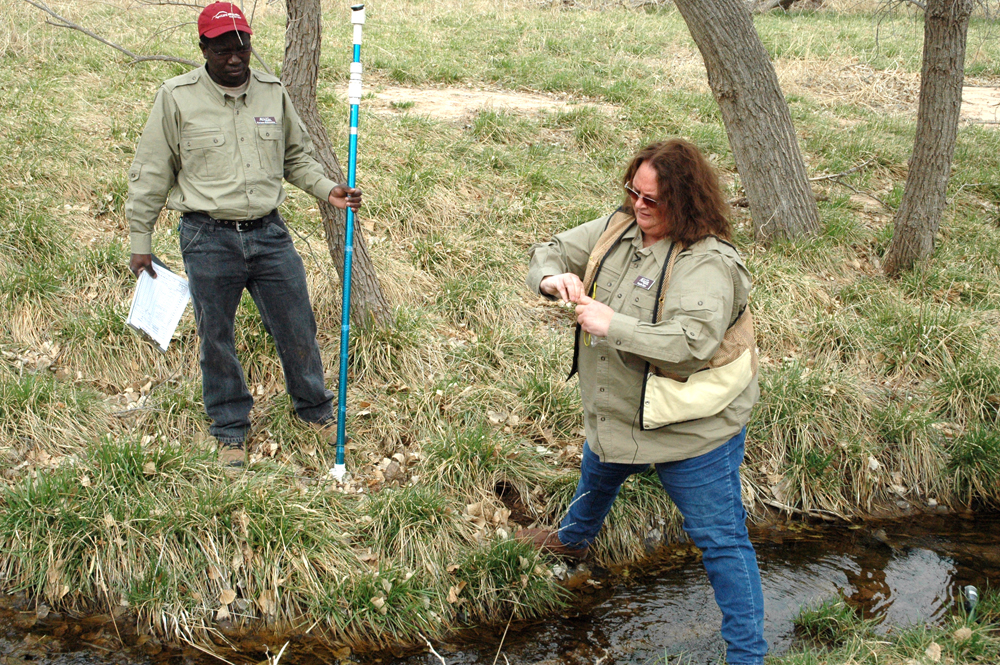Buck Creek rescue: Partnership cuts bacterial contamination in Texas stream

Finding a way to allow wildlife to have access to water, while still protecting waterways from bacterial contamination caused by wildlife is the real-life riddle members of the Texas A&M AgriLife Research team have been called on to solve in Texas’ Buck Creek watershed.
In 2000, the Texas Commission of Environmental Quality classified Buck Creek as impaired due to bacteria levels that exceeded the Texas Surface Water Quality Standards. The creek, which is in the Red River Basin, looked clean and stream life appeared healthy. But 20 water samples collected quarterly between 1995 and 2000 at one Buck Creek monitoring site showed that bacteria levels fluctuated between normal and potentially harmful levels.
At the request of local stakeholders, the Texas Water Resources Institute developed the Buck Creek Watershed Partnership in 2004 to begin to identify and address the problem.
That’s when Phyllis Dyer, AgriLife Research’s Buck Creek watershed coordinator, was enlisted to help monitor Buck Creek’s water quality and come up with potential solutions.
To understand the impact that livestock had on the elevated water bacteria levels, researchers first collected fecal samples from animals throughout the region and sent them to Texas’ DNA library in El Paso for testing.
Researchers then sampled the water to see if the bacteria in the water matched bacteria found in the fecal samples.
“We took water samples for about 18 months. And we sent the water samples off—there were about 500 of them—and any E. coli that we found there were matched to E. coli that was in the DNA library,” Dyer said. “We found that the most significant source of bacteria came from wildlife and feral hogs in that area, about 50 percent.”
Once researchers understood that fecal contamination from animals was the main source of Buck Creek’s elevated bacteria levels, they had to come up with solutions to alleviate the contamination while still allowing livestock to access the water supply.
To curb bacteria loading from livestock, researchers relied on cooperation from local ranchers and landowners to effect change. About half of the area’s ranchers cooperated, many of whom helped by moving livestock food sources away from Buck Creek.
“One thing they started doing was moving what we call mineral tubs that they put out for the cattle in the winter and during periods of drought. They started moving those farther and farther away from the creek, and that got the cattle to spend less time in the creek,” Dyer said. “There are a few things we can manipulate and a few things that we cannot, and since wildlife is the most significant source of bacteria, the only thing we could really do anything about was anything that was livestock or human bacteria.”

Phyllis Dyer takes a sample from Buck Creek as fellow associate, Partson Muvumba, looks on (Credit: Texas A&M AgriLife Research, Kay Ledbetter)
Moving food sources away from Buck Creek helped reduce direct fecal contamination in Buck Creek, as well as runoff from the land. However, that didn’t address one of the main causes of animal contamination: feral hogs.
Feral hogs are especially prone to contaminating water supplies. They spend a lot of time playing in the water and rolling around the mud along the water’s edge. But keeping free-roaming, wild animals out of the creek takes more than cooperation from ranchers.
The U.S. Department of Agriculture helped fund a program to hunt feral pigs from helicopters. This drastically reduced the hog population, which in turn, helped reduce hogs’ bacteria imprint in the region.
Researchers also found some evidence that ranchers who cleared tree coverage in areas close to the creek enjoyed healthier water. This is thought to be attributable to the sun’s UV rays disinfecting the water and a lack of shade attracting fewer animals to congregate around the water’s edge.
Recent water quality tests have shown that Buck Creek has improved to the point that it is now officially classified as healthy: After nine years of thorough water quality monitoring and communal cooperation, the Buck Creek watershed has been removed from the Texas Commission on Environmental Quality’s list of impaired waterways.
Top image: A healthy riparian buffer zone on Buck Creek near U.S. Highway 83 works to protect water quality during runoff events. (Credit: Texas AgriLife Research)





0 comments